市场资讯及洞察

S&P 500 and ASX Rally as Big Banks Drive Markets
Both the S&P 500 and ASX have rallied on the back of stronger-than-expected major bank earnings reports on both sides of the Pacific.
In the US, Bank of America reported a 31% year-over-year increase in earnings per share at $1.06, exceeding Wall Street's estimate of $0.95. Meanwhile, Morgan Stanley delivered a record-breaking quarter with EPS of $2.80, a nearly 49% increase from the same period last year.
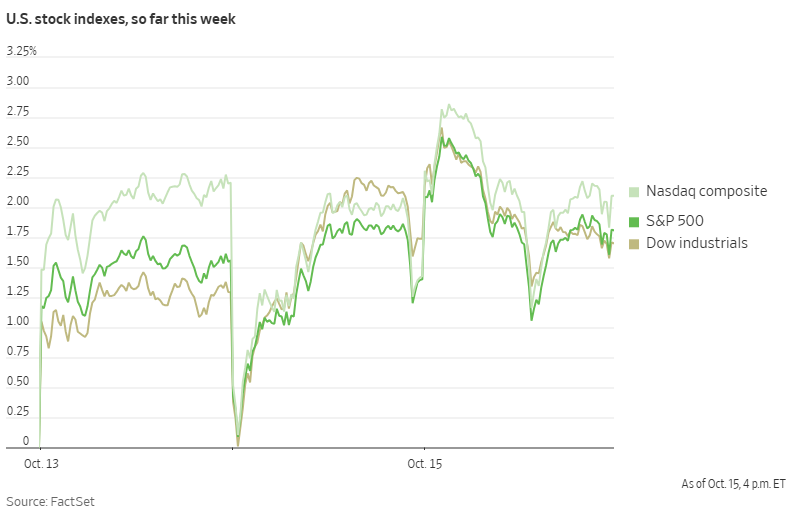
On the Australian front, the benchmark ASX 200 leapt 1.03% to 8990.99, with all four major Australian banks playing a major role. CBA closed 1.45% higher, Westpac 1.98%, NAB 1.87%, and ANZ 0.53%.
These strong bank results indicate broader economic strength, despite recent concerns about US-China trade tensions. US Treasury Secretary Scott Bessent emphasised that Washington did not want to escalate trade conflict with China and noted that President Trump is ready to meet Chinese President Xi Jinping in South Korea later this month.
With the third-quarter earnings season just getting underway, these early positive results from financial institutions could prove as the start of continued market strength through to the end of the year.
U.S. Government Shutdown Likely to Last Into November
Washington remains gridlocked as the U.S. enters its 16th day of shutdown. With no signs of compromise on the horizon, it appears increasingly likely the shutdown will extend into November and could even compromise the Thanksgiving holiday season.
Treasury Secretary Scott Bessent has warned "we are starting to cut into muscle here" and estimated "the shutdown may start costing the US economy up to $15 billion a day."
The core issue driving the shutdown is healthcare policy, specifically the expiring Affordable Care Act subsidies. Democrats are demanding these subsidies be extended, while Republicans argue this issue can be addressed separately from government funding.
The Trump administration has taken steps to blunt some of the shutdown's immediate impact, including reallocating funds to pay active-duty soldiers this week and infusing $300 million into food aid programs.
However, House Speaker Mike Johnson has emphasised these are merely "temporary fixes" that likely cannot be repeated at the end of October when the next round of military paychecks is scheduled.
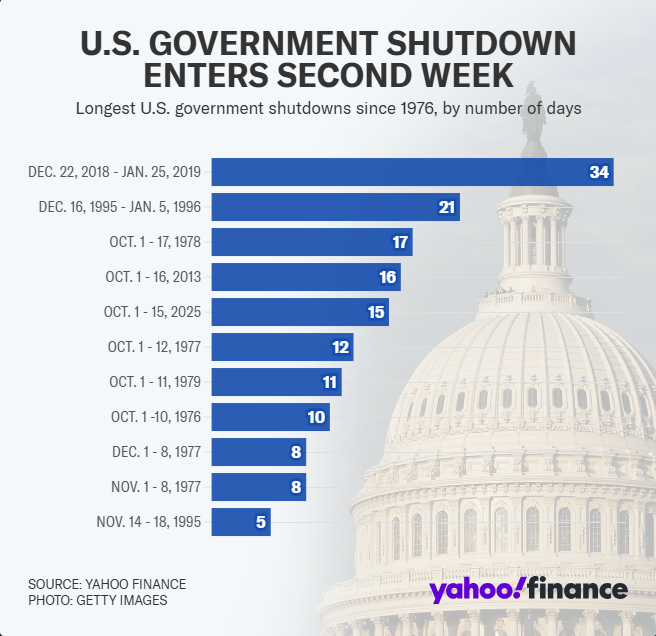
By the end of this week, this shutdown will become the third-longest in U.S. history. If it continues into November 4th, it will surpass the 34-day shutdown of 2018-2019 to become the longest government shutdown ever recorded.
This prolonged shutdown adds another layer of volatility to markets. While previous shutdowns have typically had limited long-term market impacts, the unprecedented length and timing of this closure, combined with its expanding economic toll, warrant closer attention as we move toward November.
Trump Announces Modi Has Agreed to Stop Buying Russian Oil
Yesterday, Trump announced that Indian Prime Minister Narendra Modi has agreed to stop purchasing Russian oil. He stated that Modi assured him India would halt Russian oil imports "within a short period of time," describing it as "a big step" in efforts to isolate Moscow economically.
The announcement comes after months of trade tensions between the US and India. In August, Trump imposed 50% tariffs on Indian exports to the US, doubling previous rates and specifically citing India's Russian oil purchases as a driving factor.

India has been one of Russia's top oil customers alongside China in recent years. Both countries have taken advantage of discounted Russian oil prices since the start of the Ukraine invasion.
Analysis suggests India saved between $2.5 billion to $12.6 billion since 2022 by purchasing discounted Russian crude compared to other sources, helping support its growing economy of 1.4 billion people.
Trump suggested that India's move would help accelerate the end of the Ukraine war, stating: "If India doesn't buy oil, it makes it much easier." He also mentioned his intention to convince China to follow suit: "Now I've got to get China to do the same thing."
The Indian embassy in Washington has not yet confirmed Modi's commitment. Markets will be closely watching for official statements from India and monitoring oil trading patterns in the coming weeks to assess the potential impact on global energy flows and prices.
Chart of the Day - Gold futures CFD (XAUUSD)
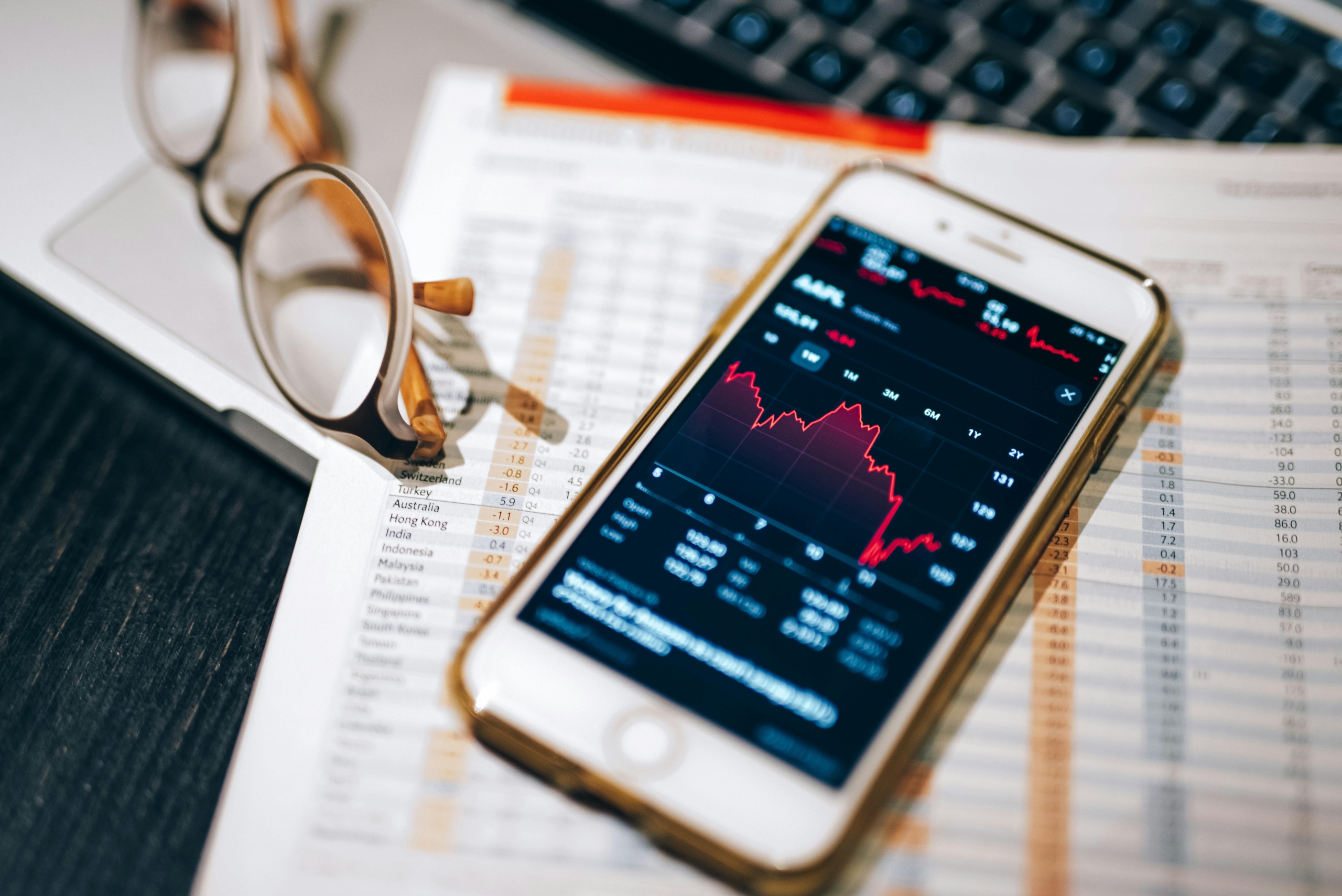

北京时间周三凌晨,美股三大指数走势分化,科技板块再度领涨,标志性科技股集体走强,推动纳指上涨1.61%,站上19000点关口,距离历史高位仅剩不到6%的涨幅空间。标普500指数也上涨0.72%,继续向前高逼近。尽管道琼斯指数受到传统板块拖累小幅回落0.64%,但整体市场人气依旧高涨。这轮上涨的核心推动力来自两方面:一是美国最新公布的4月CPI数据表现温和,年化增速回落至2.3%,为近几年来的新低,核心通胀维持在2.8%,增速也创下2021年以来的最低水平;二是科技领域的积极消息频出,尤其是在全球资金加速回流背景下,高科技领域成为外部资金关注焦点。CPI温和释放积极信号,利好市场预期数据显示,CPI月度增速低于市场预期,通胀结构也相对健康。食品和能源价格总体稳定,尽管天然气成本上涨,但油价微幅下滑。医疗服务、车险和家居类产品出现一定涨幅,但并未对整体通胀造成明显压力。鸡蛋价格大跌12.7%,成为数据中的一大亮点。市场普遍解读为美联储年内降息可能性回升,美元指数因此承压回落,金价短线反弹。AI与核电板块轮番走强,成为市场焦点在资金推动下,AI板块成为本轮反弹的核心。多家科技巨头获得大额海外订单推动股价上行,芯片龙头公司获批重大项目,股价应声上涨;AI服务提供商也纷纷传出利好,行业景气度持续提升。此外,通信、航运与云服务相关企业亦受益于新一轮海外合作意向,带动产业链整体上行。与此同时,核能相关板块也迎来强劲表现。小型模块化核反应堆(SMR)概念股发布业绩后大涨逾20%,多家核技术与电力公司也在财报季中交出优异成绩单。本轮核电行情中,部分标的股价已回到前期重点布局区间之上,为投资者带来显著浮盈,部分分析师建议可考虑在6月择机减仓锁定利润。市场信心恢复,避险情绪降温伴随通胀降温与市场信心修复,恐慌指数继续回落,油价走势趋稳,资金对后市预期趋于积极。量子计算概念股短线虽受财报不及预期影响出现调整,但中长期逻辑未变,仍具备进一步向上空间。相关公司将在本周继续披露财报,预计将为板块下一步方向提供关键指引。投资者策略展望从中期趋势来看,AI应用和核电相关板块仍是当前市场最具成长潜力的主线方向。宏观环境层面,美国核心通胀持续回落,政策面释放温和信号,为成长板块提供了良好的估值修复窗口。叠加外部合作加深和科技项目推进,市场结构性行情值得持续跟踪。建议投资者重点关注科技和清洁能源赛道,适时进行高低切换,同时密切跟进本周后续的财报及宏观经济数据,合理调整持仓节奏,把握结构性机会。联系方式:墨尔本 03 8658 0603悉尼 02 9188 0418中国地区(中文) 400 120 8537中国地区(英文) +248 4 671 903作者:Xavier Zhang | GO Markets 高级分析师
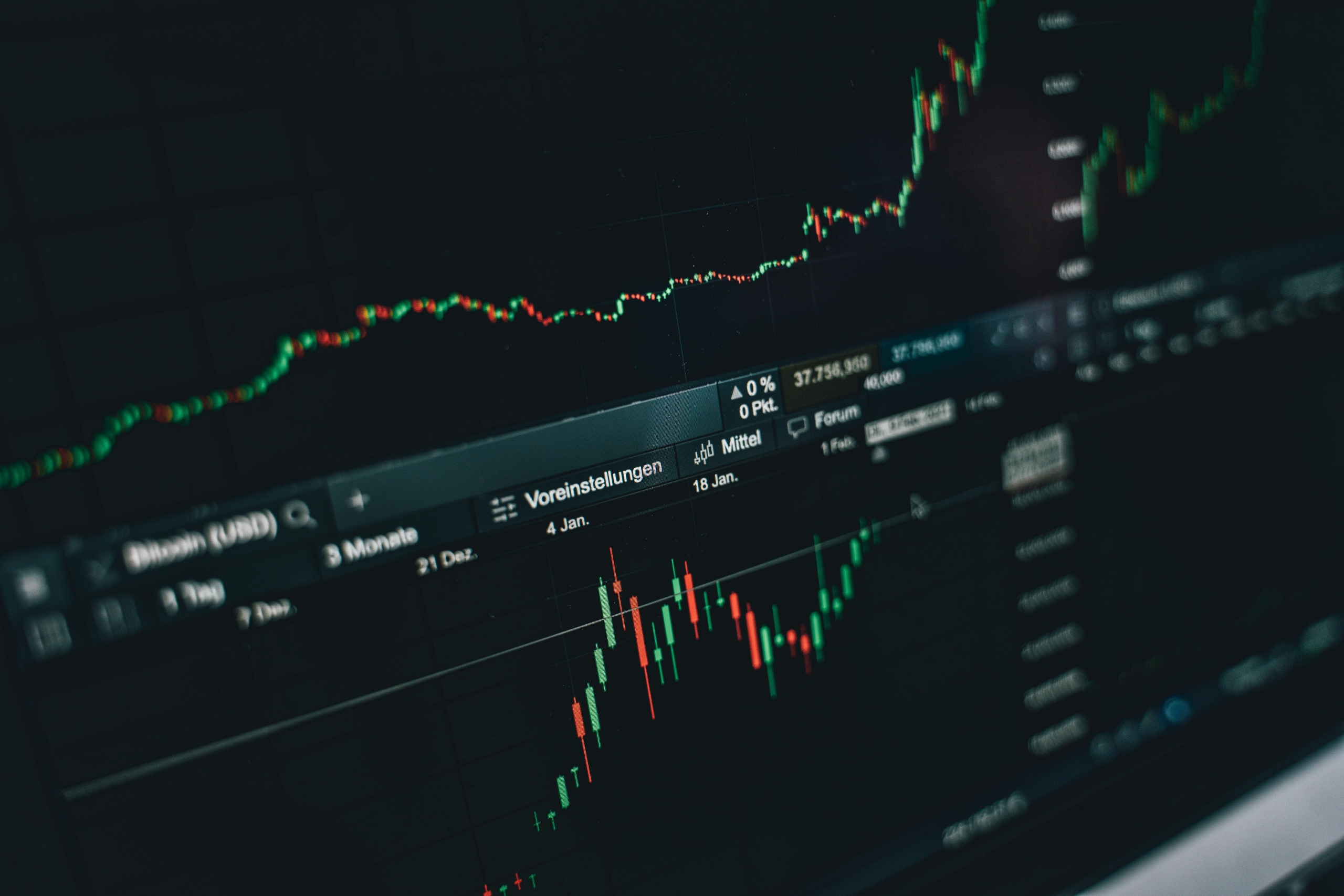

在上一篇文章中,我们介绍了如何注册 cTrader 账户,以及如何在平台上浏览并比较不同的跟单策略。本篇我们将继续深入,介绍在选定好一个策略之后,如何入金并正式开始复制交易(跟单交易)。当你登录 cTrader 平台,挑选到一个满意的策略后,操作流程其实非常简单:进入策略主页,从策略列表中选择一个你感兴趣的策略,点击开始复制(Start Copying)按钮。

其中在每个策略主页上,我们会看到三个费用指标:P(绩效费),M(管理费)和V(交易量费)。这些费用会直接影响你的实际收益,因此在决定是否复制一个策略前,务必要了解其成本结构。具体的计算公式可以参考 cTrader 官网说明: https://help.ctrader.com/ctrader-copy/fees-calculation/
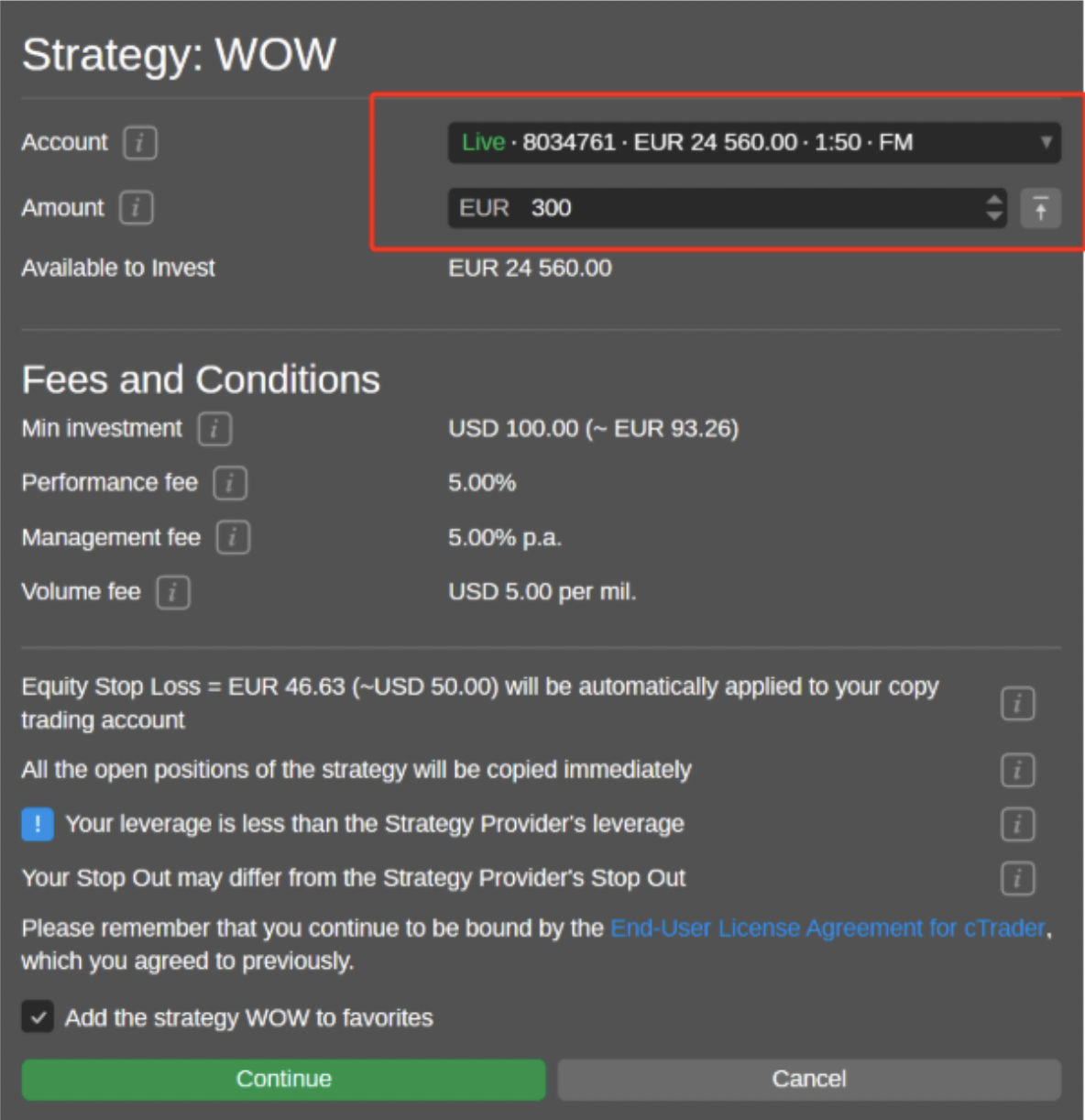
弹出窗口后,从下拉列表中选择你希望用于跟单的账户,输入计划投资的资金金额,点击确认。此时,你账户中的资金将转入一个专门用于复制交易的子账户,该账户会开始自动复制所选策略提供者的操作。你可以在账户页面中查看各个策略的投资统计数据,掌握当前跟单账户的实时表现。

复制开始后,cTrader 提供了一系列实用的账户管理功能,你可以:添加资金或提取资金;设置止损限额;暂停复制或重启复制;查看账户详细的统计数据,如投资回报率、每月表现、历史成交记录和盈亏分析等。这些功能都可以在策略页面的投资统计界面,通过操作下拉菜单轻松完成。虽然跟单交易大大简化了投资者的操作流程,但使用过程中仍需注意以下几点:1. 股票类交易不被复制:如果策略提供者交易的是股票或股权类产品,这些交易不会被复制到你的账户。2. 账户条件限制复制操作:若投资者账户资金不足、杠杆比例低于策略提供者,或可用保证金不够,则某些策略交易将无法被复制。3. 复制失败的存在特殊情况:比如在策略中出现交易量高于经纪商允许的最大手数时,系统将无法为跟单账户开仓。4. 资金变动影响持仓规模:向复制账户添加或提取资金时,现有持仓可能会根据新的权益比例进行调整。调整公式如下:复制交易手数 = (投资者账户权益 / 策略提供者账户权益) × 策略交易手数举个例子:如果策略提供者账户权益为4000美元,投资者账户权益为1000美元,策略提供者开仓4手,那么投资者账户将复制1手交易。通过以上介绍,你已经了解了在 cTrader 平台上如何从选择策略到真正开始跟单交易的完整流程。跟单交易为没有太多交易经验的投资者提供了一个便捷的参与市场的方式,但在开始前务必要了解费用结构和潜在风险,理性评估再做决定。免责声明:GO Markets 分析师或外部发言人提供的信息基于其独立分析或个人经验。所表达的观点或交易风格仅代表其个人;并不代表 GO Markets 的观点或立场。联系方式:墨尔本 03 8658 0603悉尼 02 9188 0418中国地区(中文) 400 120 8537中国地区(英文) +248 4 671 903作者:Michael Miao | GO Markets 悉尼中文部
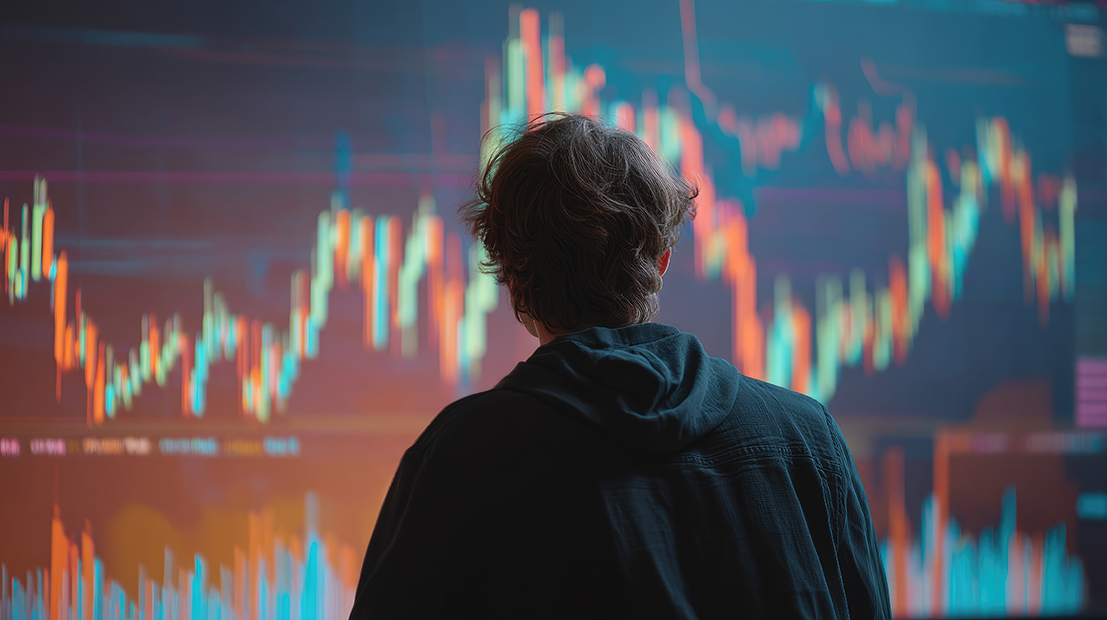

Investors globally and domestically are stuck in this weird holding pattern. We are all clearly waiting for more definitive signals on the direction of tariffs and broader policy settings, and despite US-China trade talks, we would argue this is news for news' sake – it is not fact. This uncertainty is casting a long shadow over the market, but you wouldn’t know it; the recent volatility has all but reversed equity losses.Beneath the surface, several important trends are shaping the outlook, particularly around the movement of prices for both commodities and consumer goods. For example, look at how local retailers respond with their own pricing strategies to deal with the ‘new trade order’. At the same time, expectations around index rebalancing are adding another layer of complexity, with market participants closely watching which companies might move in or out of major indices in the coming months as geopolitics and the digital age move weightings around.Investors are acutely aware that the next major move will likely be dictated by policy announcements, which could come at any moment and in any form, and so are scrutinising every development for clues.First - In this environment, we are very mindful of oil, any second-order effects that lower oil prices as a traded commodity and at the petrol pump, could have on the broader economy for Australia and, by extension, our China-linked economy. A deal between the US and China, but also Russia and Ukraine, would be huge for oil.Second, there is also an ongoing debate about whether the Australian economy and local equity markets will see any real benefit from a period of goods disinflation, or whether the impact will be more limited than some expect.Looking ahead to the June 2025 index review, expectations are that the level of change will be more subdued compared to what was seen in March. The most significant adjustment on the horizon is the likely addition of REA Group to the S&P/ASX 50 Index, replacing Pilbara Metals. Beyond that, Viva Energy is currently positioned within the 100–200 range and could move up if conditions are right, while Nick Scali is well placed to enter the 200 should a spot become available, and in a rate-cutting environment, consumer discretionary is going to be interesting. The June rebalance is due to be announced on June 6 and implemented on June 20, so there’s plenty of anticipation building as investors position themselves ahead of these changes.Zooming out to the macroeconomic front, several catalysts are likely to shape the market narrative in the weeks ahead.Consumer and business sentiment, first-quarter wage growth, and the April labour force data are all in sharp focus this week and next. The expectation is that consumer sentiment will have continued to decline in May, extending the broader deterioration that’s been in place since the US tariff announcements. Business surveys for April show that both confidence and conditions are holding steady, tracking above their long-run averages.Turning to Wednesdays, Wage index growth is expected to have accelerated in the first quarter, with forecasts pointing to a 0.8% increase quarter-on-quarter and a 3.9% rise year-on-year. This acceleration is being driven by a combination of ongoing tightness in the labour market, stronger enterprise bargaining agreements, and legislated increases in childcare wages.Thursday’s labour force data for April is expected to show 40,000 jobs added, with the unemployment rate holding steady at 4.1%. A slight uptick in participation to 66.9% is also anticipated, reflecting the ongoing strength of the jobs market.In the housing sector, the latest data is less encouraging. Building approvals fell by 8.8% in March, with a 13.4% drop in house approvals. These figures are weaker than both market and consensus expectations, and the annualised rate has now fallen to 160,000. This points to ongoing challenges in the construction sector and raises questions about the sustainability of the housing market recovery. This will bring the RBA and the newly elected Federal government into sharp focus – action is needed, but what that looks like is hard to define.Commodities markets have also seen significant movement, with oil prices dropping below US$60 per barrel, the lowest point since early 2021. This has brought OPEC into sharp focus. The crux question is whether OPEC will attempt to chase prices lower or instead move to stabilise the market. So far, they have pushed prices with deliberate oversupply to punish certain nations – this, however, is unsustainable and will have to change soonCouple this with weaker demand from Asia, and a volatile US dollar is also playing a role, with Brent crude now trading at $55 per barrel. These developments are feeding into broader concerns about global growth and the outlook for commodity exporters.Looking at the local currency and AUD has shown remarkable resilience, supported by a meaningful improvement in the country’s energy trade balance and a weaker US dollar. However, the next major test for the currency will come with the release of the US CPI data on Wednesday, which could set the tone for global markets in the near term – is the Fed out of the market in 2025? This will impact the USD.Looking at the globe, the market and financial landscape is still navigating a complex web of challenges, with persistent inflation, potential tariff implementations, and evolving economic dynamics all in play.Market participants are increasingly focused on how these factors interact and influence everything from consumer pricing to investment strategies. Central bank decisions, especially from the Federal Reserve, have been pivotal in moderating market sentiment, while ongoing discussions about trade policy continue to reshape the global economic environment. Tariffs, in particular, are forcing companies to rethink their supply chains. You only must look at the US reporting season and the likes of Ford, GM, Nike and the like, all scrapping forward guidance and highlighting the impact tariffs are having on cost. The second event that is now becoming ‘actual is that the higher input costs are often now being passed on to consumers. The broader issue here is that this can reduce household disposable income and slow broader economic growth.So, although the excitement of early April has subsided, it's only a social media release away. That means that we as investors are navigating a period of heightened uncertainty, with every policy announcement, economic data release, and market move being scrutinised harder than normal as we look for what it might signal about the path ahead.The interplay between inflation, tariffs, and shifting economic dynamics means that flexibility and vigilance will be essential for anyone looking to make sense of the current environment and position themselves for what comes next.
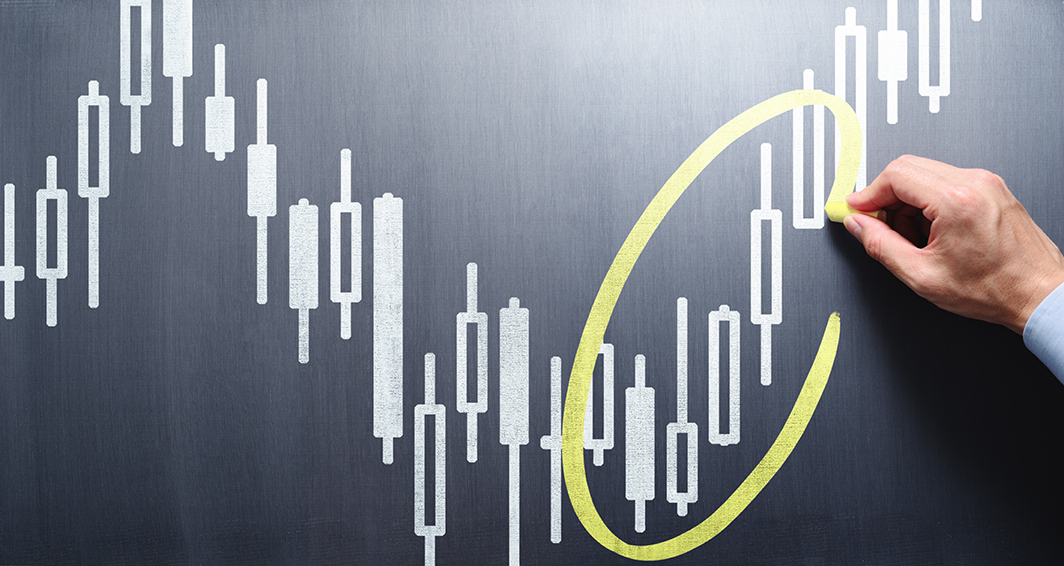

IntroductionSo, what is a Trading Edge?There is much written and many videos on social media that are out there singing the praises of developing a trading edge, and why it is a must if you want trading success, BUY in terms of practical “how do a get one” advice, most that is written seems to fall short of something substantive that you as a trader can work with.When you read articles discussing the concept of an "edge," they're talking about having some kind of advantage over other market participants; after all, there are always winners and losers in every trade.However, many traders are often mistakenly informed that edge relates solely to a system, but the reality is that it encompasses so much more than that. While systems certainly matter, your edge also includes how you think, act, and execute under pressure when YOUR real money is on the line.Your advantage may stem from speed, knowledge, technology, or experience, or better still a combination of all of these, the key point here is that you're not trading like so many others without the appropriate things in place and the consistency that is required when trading any asset class, on any timeframe to achieve on-going positive outcomes.Here's something worth considering before we have a deeper dive into your SEVEN secrets. Simply having a plan, trading it consistently, and evaluating it regularly gives you an advantage over more than 75% of traders out there. Most market participants lack these basic but critical elements of good trading practice. Just doing these fundamental things already puts you ahead of most, but refining further will truly set you apart from the crowd.At its core, a trading edge can be defined as a consistent, testable advantage that improves your odds over time. It's not about achieving perfection but developing repeatability in results and establishing statistically positive, i.e. evidence-based action that will work in your favour.So, despite what you may have seen or heard previously, a complete edge combines idea generation, timing, risk management, and execution; it's not just about focusing on high probability entries. It's a whole process, not a single isolated rule or signal.Just to give an example, a trading system that wins only 48% of the time may not seem that impressive on the surface to many, but if it consistently delivers a 2.5:1 reward-to-risk ratio can still achieve long-term profitability. The key issue in this example is the combination of numbers that creates the result, AND the word consistently.That IS an edge.In this article, we will explore SIX things that are not so regularly talked about in combination, this is the difference, and an approach that can move you towards creating such an edge.As we move through each of these, use this as your trading checklist for potentially taking action on the things that you need to take to the next level, and so take affirmative steps to sharpen your edge.Secret #1: An Edge Is Something You Build, Not Something You FindAs traders, we are always looking for the “holy grail”, that system or indicator that means we will be a success. As previously discussed, that is NOT what constitutes an edge. We need to let go of the idea that there's something magical waiting to be discovered and get to work on the things we need to.Your edge comes from testing, refining, and aligning strategies with your personal strengths and market access. The best edges are customised to your specific goals and circumstances, not simply downloaded from someone else's playbook, you may have heard on a webinar, conference or TikTok post.Your strategies should be a natural fit with your daily routine, available tools, trading purposes, and emotional style. If your approach you choose clashes with your lifestyle, mindset or experience, your execution and results will invariably suffer when you are in the heat of the market action and have decisions to make. For example, if you are a trader working a full-time job, it may be wise to either build a 4-hour chart trend model that matches your limited availability, consider some form of automation or restrict yourself to small windows of opportunity on very short timeframes for times that you can ringfence.We often come across systems that look attractive on the surface. When you copy others, you might get their trades, but you won't have their conviction (belief in your trading system is critical in terms of execution discipline) or context, e.g., their access to markets, and so you will find that you won't match their published results.Without the required deeper understanding of why a strategy works, you'll struggle to stick with it through the inevitable trades that don’t go your way, and drawdowns that WILL always test your resolve to keep with any system.So, the key takeaway is that you must make the investment in time, in yourself as a trader and do the work as you move towards building your edge. There are no shortcuts!Secret #2: Probability of Your Edge Is Only as Good as Your DataData that you can use in your decision-making for system development and refinement can come from accessing historical test data, but more importantly, YOUR results in live market trading (whether from journaling or automated tracking).The strength of this in developing an edge depends directly on two key things.Firstly, on data being clean, i.e. the key numbers relating to what happened, and sufficient detail with a sufficient critical mass of results that allows you to see beyond the profit/loss of a handful of trades. The meticulous recording to a high quality of this evidence makes it a priority if you are to create something meaningful on which to base decisions.Poor data creates false confidence in any system developed on such with fragile strategy and forces you to rely on guesswork to fill in any gaps or because you simply haven’t got enough numbers on which to make a strategic decision.Think about this for a moment, if you have 60 trades, across three strategies, and then of those 20 trades per strategy, 10 are FX and 10 are stock CFDS, and of those 10, 5 are long and 5 are short trades, to make substantive decisions on 5 trades hardly seems like enough evidence on which to base something so important. To think that this is ok, go full tilt into the market, your confidence based on a sample so small, there is a high chance your strategy will likely break under real market pressure.Always ensure the market conditions in your testing environment reasonably match your live trading environment.Even when using backtests to try to get more evidence, which on the surface seems worthwhile, it is not without pitfalls unless due care is taken. For example, back tests performed exclusively during trending market periods won't adequately prepare your system for range-bound price action.Secret #3: Simplicity May Beat Complexity Under PressureSimple systems prove easier to create, allow you to find errors when they are occurring, and of course follow in the heat of inevitably volatile market moments. The more clarity you have about exactly what to do and when, significantly reduces hesitation and increases follow-through when decisive trading action may matter most.A complex system, as a contrast, increases your “thinking load”, slows your reaction time when speed of decision may count, and if you have 14 criteria to tick before action, may lead to the “that’s close enough” temptation for trade actions. Adding more indicators without evidence rarely does anything but make your charts look more impressive and typically leads to more doubt and “short-cutting” rather than better results.As a formula, more rules = more system and trader fragility, which is potentially a good rule of thumb to have in place.Consider how some automation, for example, the use of exit-only EAS, can help simplify the execution of otherwise complex situations and achieve consistency.It is not inconceivable that a trader using a simple price-only breakout strategy consistently outperforms another with a 12-indicator system by executing cleanly during volatile news events when others freeze with so-called “analysis paralysis”.Secret #4: Edge Disappears Without Execution DisciplineYou could have the most brilliant, robustly tested, evidence-based strategy on the planet and yet the reality of why many traders fail to reach their potential is at the point of action. Plans are often skipped, rushed, or mismanaged, and the harsh reality is that your system of systems that you have invested a considerable amount of effort and time to develop may crumble without precise, consistent and disciplined execution.Emotional interference in decision making is something we discuss regularly at education sessions, whether from fear of loss, greed, revenge trading or the fear of missing out on potential profit, can kill performance, even when presented with textbook setups and times when price action is telling you it is time to get out. Even momentary lapses in judgment and actions originating from cognitive biases can undo hours or days of careful preparation or remove the profit from several previous trades.Recency bias can creep in quickly, even after a couple of losses, where hesitation in action in an attempt to avoid the same again costs you the opportunity that the “plan-following” trade can give you.What brings your edge to life is consistency in action, not just having a good plan. The discipline of follow-through can transform a considered and carefully developed system into actual profits, and quite simply, to fail to do this is unlikely to deliver the results you seek.Secret #5: Evolve or Expire — Markets Consistently Change, So Should YouMarket circumstances, fundamental drivers and shifts in these create different conditions not only in price action and direction, but volatility and effects in sentiment can be changed for the long term, not just the next hour. If markets evolve to a new way of acting, it is logical that your systems must, at a minimum, be able to accommodate this. This is part of your potential edge that few traders master (or even look at!), but your systems must evolve accordingly when markets change. What works brilliantly in the last few months may not necessarily work forever—diligently monitor changes and adjust your approach.Static systems will potentially degrade in outcomes without regular review and adaptation, or at best have significant periods of underperformance. Perhaps think of your strategy as requiring a review and maintenance plan like any sophisticated machine.In practical terms, system evolution means identifying when strategies do well and not so well, including evaluation of performance in different market conditions. With this information, you can make informed changes based on evidence, not random tinkering or looking for the next new indicator to add.Remember, you always have the ultimate sanction of switching a strategy off completely during specific market conditions that may mean risk is increased.Secret #6: Effective Risk Management Is an Edge MultiplierIt is difficult when talking about a multi-factor approach to hone down on the most influential factor, but this may be it.Your position sizing approach in not only single but multiple trades determines whether your edge, even when followed to the letter, can scale profitably or self-destruct dramatically. The same system can either give you ongoing positive outcomes or destroy an account based depending on how you size your positions.Risk too much, and you'll potentially blow your account up; risk too little, and you'll generate gains that make little difference to the choice you can make with any trading success.Your sizing should align with both your system's statistical properties as we discussed before and your psychological comfort zone, as the latter is equally something that will develop over time with sufficient belief in your system – a key factor as we have discussed at length in other articles, in the ability to be disciplined in trade execution.Only scale your position sizing after accumulating a critical mass of trades and establishing a clear set of rules based on a record of positive trading metrics for doing so. Premature scaling should only be done when you have proved not only that your system looks as though it performed favourably but also that you have the consistency to move to the next level.Finally on this point, and perhaps the topic of a future article in more detail, concerning the previous point relating to market conditions, once you have developed a way of identifying market conditions and fine tune strategies accordingly, there is of course the possibility of using this information to position size more effectively, To give a simple example something like market condition A =1% risk, market condition B = 2% risk.Summary and Your Actions...As stated earlier, a good approach to this article is to use it as a checklist. Invest some time to review the material covered here and make a judgment of where you are right now with some of the things covered.For some of you, there may be a few things to work on; for others, it may be just some checking and fine-tuning. Either way, identify at least one specific area to work on immediately. One insight that you implement properly is worth far more in terms of the difference it can make than a few insights you just acknowledge but forget to take action on.Ask yourself honestly: "On a scale of 1-10, how do I perform on each of the above in the pursuit of my current trading edge?Or perhaps where would I like it to be six months from now?"Build yourself a roadmap to achieve these, and of course, commit to and follow through in making it happen.


过去一周,全球金融市场整体表现平稳,美股维持震荡格局。尽管美联储最新利率决议和主席鲍威尔的讲话基本宣告了上半年降息希望的落空,但市场情绪并未因此大幅波动,投资者似乎已逐步消化这一预期变化。与此同时,全球贸易格局出现关键进展。英国与美国正式签署关税协议,成为继脱欧后英美经贸关系中的重要里程碑,也为其他主要经济体与美方的后续谈判提供了参考模板。这一事件为国际市场注入稳定信号,被视为近期最具影响力的地缘经济事件之一。中美高层会谈带来突破预期本周伊始,市场关注的焦点迅速转向中美高级别经贸会谈。据多方渠道消息显示,周末开始的谈判取得一定积极进展,双方在日内瓦的交流释放出诸多利好信号。尽管目前尚未公布最终细节,但整体气氛相对乐观。从投资角度看,尽管一次性全面达成协议的可能性仍需谨慎评估,但只要谈判持续进行且未出现明显分歧升级,市场便视为积极信号。受此影响,本周一早盘美股大幅高开,延续了周末复盘时的积极预判。若后续公布的CPI和零售销售数据继续维持温和区间,美股有望在本周保持强势。板块聚焦:AI、电力与量子科技行业板块方面,市场热度仍集中在AI应用和能源转型相关的核心企业。特别是在当前全球利率预期趋稳背景下,科技成长板块的吸引力持续上升。本周另一个值得重点关注的方向是量子计算概念股,不少成分企业将发布财报,在宏观环境偏暖的支撑下,或存在交易性机会。此外,中概股本周也迎来财报密集期,京东、阿里巴巴与腾讯等公司将陆续公布季度业绩。若中美谈判继续释放正面信息,不仅美股中的中概股有望受益,港股与A股亦有可能同步获得资金情绪提振。澳股受益外部环境稳定,汇市波动加剧在政治格局趋稳的大环境下,澳洲市场也延续震荡偏强走势。尤其是美股带动下,澳股科技和资源板块表现相对稳健,配合即将召开的货币政策会议,市场对利率政策可能转向也保持关注。外汇方面,美元指数温和上行,整体依然围绕100整数位平台震荡。前期预估美债6.5万亿美元的资金安排基本尘埃落定,也使得美元在短期内缺乏大幅贬值动力。与此同时,人民币兑美元汇率小幅反弹,早盘回升至7.22平台,表现明显强于多数亚太货币。澳元兑美元上涨0.3%,兑日元则涨超0.6%,显示出对全球利好预期较强的正向反应。黄金震荡调整,油价小幅回暖受避险需求下降影响,黄金价格早盘出现跳空低开,较前期高位大幅回调。当前市场普遍认为,金价短线回落属于合理修正,尤其是在关税风险预期缓和的背景下。若中美后续谈判公布更具体内容,不排除金价有进一步下探3200平台的可能。能源方面,油价呈现震荡回暖走势,中东地区地缘风险暂无新动态,市场对供需预期保持中性偏乐观判断。数字资产仍处平台期,比特币震荡延续数字货币市场方面,比特币继续围绕10.4万美元平台震荡,短线缺乏明确方向。在宏观消息面稳定且缺乏重大催化的情况下,预计数字资产板块仍将维持技术性整理格局。小结本周市场面临关键转折点,来自中美会谈的积极信号或将在短期内重新激发风险偏好。但投资者也需关注CPI、零售销售等数据的配合表现,毕竟经济基本面将决定行情的可持续性。结构性上看,AI应用、清洁能源、量子计算与中概股财报等热点依旧值得关注,而黄金、汇市与数字资产则更适合策略性参与。免责声明:GO Markets 分析师或外部发言人提供的信息基于其独立分析或个人经验。所表达的观点或交易风格仅代表其个人;并不代表 GO Markets 的观点或立场。联系方式:墨尔本 03 8658 0603悉尼 02 9188 0418中国地区(中文) 400 120 8537中国地区(英文) +248 4 671 903作者:Xavier Zhang | GO Markets 高级分析师


2025年5月8日,英国与美国达成了一项具有里程碑意义的贸易协议,标志着两国在“脱欧”后经济关系的重大进展,旨在缓解特朗普政府实施的全球性关税对英国产业的影响。协议核心条款1. 钢铁和铝关税取消美国将取消对英国出口的钢铁与铝产品所施加的25%关税。这一举措将直接缓解自特朗普政府2018年起因“国家安全”理由征收的惩罚性关税所造成的压力,有利于英国钢铁制造商在全球市场重建竞争力。2. 汽车关税显著下调美方将对英国汽车出口设定配额,允许最多10万辆汽车以10%的关税出口至美国,远低于此前高达27.5%的关税水平。该措施将直接惠及捷豹路虎等英国本土车企,提升其在美国市场的性价比。3. 农产品市场准入调整英国在特定配额范围内对美国牛肉和乙醇关税进行下调,但继续禁止含有激素的牛肉和氯洗鸡肉,以维护本国食品标准。这种“有限开放”平衡了食品安全与贸易互惠。4. 航空与工业品合作扩大美国将撤销对英国飞机零部件的关税。同时,英国航空公司承诺向波音公司采购总值100亿美元的飞机,有利于稳固美英在航空制造业的合作链条。5. 制药与数字贸易潜在开放协议中未设具体条款,但为英美未来在数字服务、数据流通、制药审批与知识产权保护方面的合作埋下伏笔。尤其在数字经济日益全球化的背景下,这一方向具有战略意义。斯塔默首相将该协议称为“历史性的一步”,强调其对英国汽车和钢铁行业数千个就业岗位的保护作用。尽管如此,批评者指出,协议未能全面解决数字服务、国家医疗服务体系(NHS)开放等关键问题,且英国在某些领域的让步可能过大。此外,协议并未取消特朗普政府实施的10%全球性关税,这意味着英国出口商仍面临一定的贸易壁垒。尽管如此,业界普遍欢迎该协议,认为其为未来更广泛的贸易合作奠定了基础。对比胡佛关税大棒:很多人觉得特朗普的关税政策会导致胡佛时代的大萧条,但今天的美国与胡佛时代的美国不可同日而语,回看各国对胡佛的关税政策的反应:1. 加拿大:作为对美国关税上调的直接回应,加拿大迅速提高了对美国产品的关税,并优先寻求与英国及其殖民地的贸易安排。美加贸易关系严重受损。2. 英国:英国放弃长期以来的自由贸易政策,于1932年在渥太华帝国会议上推出“帝国特惠制度”对英联邦国家实施优惠关税,排斥美国商品。3. 德国与法国:欧洲大陆多国采取报复性关税或配额限制,限制美国商品进口,并强化区域内贸易保护,转向双边协定。4. 日本:日本同样提高对美国商品的关税,开始加强对满洲和东南亚的经济控制,寻求自给自足和经济扩张路径。5. 拉丁美洲国家:部分拉美国家因对美出口受阻,转向与欧洲进行更密切的贸易联系,并实施进口替代工业化政策。可见当时各国对强加关税的行为是顽强反抗的,直至三年后罗斯福上台,进行“互惠贸易和双边协定”才缓和了当时紧张的国际贸易,但经过这三年的贸易冲突,世界经济体系已经千疮百孔,导致了全球经济大萧条,进而引发了二战。很多人就会担心今天的关税政策会再次导致全球性的经济崩溃。但介于美国的霸主地位,很多国家会像英国一样妥协,并且在特朗普眼里关税不是目的,谈判获利才是结果,最后这场关税大战,不会像胡佛时代的规模巨大,不会像胡佛时代的三年后才着手解决,也就不会带来全球大萧条。联系方式:墨尔本 03 8658 0603悉尼 02 9188 0418中国地区(中文) 400 120 8537中国地区(英文) +248 4 671 903作者:Mill Li | GO Markets 墨尔本中文部

